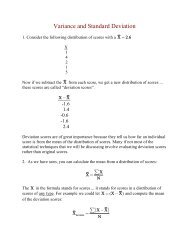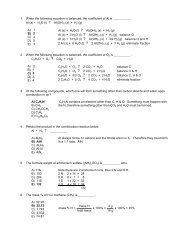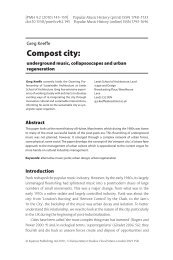A Digital Spectral Classification Atlas - Appalachian State University
A Digital Spectral Classification Atlas - Appalachian State University
A Digital Spectral Classification Atlas - Appalachian State University
Create successful ePaper yourself
Turn your PDF publications into a flip-book with our unique Google optimized e-Paper software.
A <strong>Digital</strong> <strong>Spectral</strong> <strong>Classification</strong> <strong>Atlas</strong>R. O. GrayDept. of Physics and Astronomy<strong>Appalachian</strong> <strong>State</strong> <strong>University</strong>v. 1.07Not for RedistributionJanuary 30, 20091
IntroductionThe MK <strong>Spectral</strong> classification system was founded by W.W. Morgan and P.C. Keenan in theyear 1943, with the publication of the first photographic spectral classification atlas, An <strong>Atlas</strong>of Stellar Spectra (Morgan, Keenan & Kelleman, 1943). Since that time, the MK systemhas been extensively revised and refined by Morgan, Keenan and others. In the late 1970’s,two important spectral atlases, summarizing the development of the MK system up to thattime, were published. These atlases, the Revised MK <strong>Spectral</strong> <strong>Atlas</strong> for Stars Earlier than theSun by Morgan, Abt & Tapscott (1978) and An <strong>Atlas</strong> of Spectra of the Cooler Stars: TypesG,K,M,S and C, by Keenan & McNeil (1976), are the inspiration for the various versions ofthis digital spectral classification atlas. Indeed, some of the pages in this atlas are “digitized”versions of pages from those two atlases.The MK spectral classification system is a natural, empirical system of classification whichuses in the classification process only the directly observable features in the spectrum. TheMK system is defined by a set of standard stars, and classification on the system is carriedout by the comparison of the program star with the standard stars, taking into accountall of the features in the spectrum. The use of standards is vital because it maintains theautonomy of the system as well as ensuring that different observers will classify stars on thesame system.When the MK system was first defined, it was based on photographic spectra in theblue-violet part of the spectrum. This was done by necessity, as scientific photographicemulsions in the 1940’s were sensitive only to blue-violet light. However, it was a fortunatechoice, as the blue-violet portion of the spectrum (essentially from the Ca II K-line to Hβ )contains a high density of astrophysically important atomic lines and molecular bands, whichallow accurate classification of the star in a two-dimensional temperature, luminosity grid.<strong>Classification</strong> systems can and have been set up in the red, IR and the ultraviolet. Theseshould remain independent of the traditional MK system, as different parts of the spectrumcan sample different levels in the atmosphere of the star.This version of the <strong>Digital</strong> <strong>Spectral</strong> <strong>Classification</strong> <strong>Atlas</strong> should really be considered asynopsis of the much more extensive Stellar <strong>Spectral</strong> <strong>Classification</strong> by R.O. Gray and C.J.Corbally, to be published by Princeton <strong>University</strong> Press in spring, 2009. Since I have borrowedextensively from that book for this atlas (all the figures in this atlas except for Figure29 are from that book), this atlas should not be redistributed either electronically or inhardcopy form. I urge you to buy the book when it comes out!Many, but not all of the spectra in this atlas were obtained with the Gray/Miller spectrographon the 0.8 meter telescope of the Dark Sky Observatory (DSO), using a CCD detector.For the DSO spectra, two spectral resolutions are used in this atlas. Most of the illustrationsuse spectra obtained with the 1200g/mm grating, which gives a spectral resolution of 1.8Å/2pixels and a spectral range of 3800Å – 4600Å, but some illustrations, especially those of thelater-type stars (K, M, C and S) use spectra obtained with the 600g/mm grating. These havea resolution of 3.6Å/2 pixels, and a spectral range of 3800Å – 5600Å. The higher resolutionspectra are presented in a rectified intensity versus wavelength format, in which the spectralcontinuum has been normalized to unity. The 3.6Å resolution spectra, for the most part, arepresented in a flux versus wavelength format; this format provides additional information on
the energy distribution of the star, and is to be preferred for the cooler stars, as these starshave essentially no continuum points in their spectra. For ease of illustration, the fluxes havebeen normalized to unity at one consistent point in the spectrum.Since the publication of the two most recent photographic spectral atlases mentioned inthe paragraphs above, the MK system has undergone considerable refinement and extension.Important work in refining and extending the MK system to dimensions beyond the traditionaltwo-dimensional temperature/luminosity grid has been carried out by Keenan andco-workers in the addition of abundance indices for the late-type stars, by Gray (1989), in theextension of the MK system to metal-weak F and G-type stars, by Kirkpatrick & coworkersin their careful redefinition and extension of the MK system to the M-type dwarfs and mostlately the L- and T-type dwarfs , and by Walborn in the classification of the O-type stars.All of those developments are discussed in detail in Stellar <strong>Spectral</strong> <strong>Classification</strong>. Unlikeearlier versions of this atlas, this atlas does not illustrate spectra of white dwarfs, novae orsupernovae. If you want to explore the spectra of such stars, buy the book!
The <strong>Spectral</strong> Sequence1H8/He IIHε/He IIHe IHδ/He IIHe IIHγ/He III.S.He IIHD 46233O4 V0HD 46202O9 V22 ScoB2.5 V-1Rectified Intensity-2HR 1029 B7 Vβ Leo A3 V-3HD 23585 F0 VHD 27524 F5 VFe IMg IH8HεHe IHe IN IIIHe IIHβ/He IIHe IIHδHγHβHe IHe IMg IICa II KMn ICa IFe IFe II/Ti IICH-4Sun G2 V-53800 4000 4200 4400 4600 4800 5000 5200 5400 5600Wavelength ( )Figure 1: The Main Sequence from O4 to G2, the “early-type” stars.Figures 1 and 2 show a bird’s eyeview of the spectral sequence, which is dissected andexamined in more detail in later portions of this atlas. Figure 1 shows the spectral sequencefrom the hottest “normal” stars, the O-type stars, to spectral type G2, the spectral typeof our sun. The spectra of these “early-type” stars are dominated by the Balmer lines ofhydrogen. Note how they increase in strength and reach a maximum at A2, and then fade
thereafter. The O- and B-type stars are characterized by lines of helium; the A-, F-, andG-type stars are characterized by lines of metals.21Ca IIK HMn IHδCa ICH (G-band)HβMg ISun G2 V0Fe IHγFe INormalized Flux-1MgH61 Cyg A K5 VMgH61 UMa G8 VTiO-2TiOTiOCa IGL 411 M2 V-3HγHβ-43800 4000 4200 4400 4600 4800 5000 5200 5400 5600Wavelength (¡)CaOH40 Eri C M4.5 VFigure 2: The Main Sequence from G2 to M4.5, the “late-type” stars.Molecular features first appear in the spectra of F-type main sequence stars and grow todominate the spectra of the “late-type” stars, especially those of types K and M. The mainsequence does not end at M4.5, but continues through the late M-, the L- and the T-typedwarfs, a sequence that spans the transition from hydrogen-burning dwarf stars to browndwarfs.
The Main Sequence O2 – O9Figure 3: The O-type main sequence stars. Reproduced from Stellar <strong>Spectral</strong> <strong>Classification</strong>;original figure courtesy Ian Howarth.The O-type stars constitute the hottest normal stars, and are characterized by moderatelyweak hydrogen lines, lines of neutral helium (He I) and by lines of singly ionized helium (HeII). The spectral type can be judged easily by the ratio of the strengths of lines of He I toHe II; He I tends to increase in strength with decreasing temperature while He II decreasesin strength. The ratio He I 4471 to He II 4542 shows this trend clearly.Visible in a number of stars in this figure is a broad, shallow depression, centered near
4430Å. This is an example of a diffuse interstellar band, probably due to molecules in theinterstellar medium between us and the star.
Luminosity Effects at O6.5Figure 4: A luminosity sequence at O6.5. Figure reproduced from Stellar <strong>Spectral</strong> <strong>Classification</strong>;original figure courtesy I. Howarth.Figure 4 shows a luminosity sequence at a spectral type of O6.5. At this spectral type anumber of luminosity criteria are active. Note that in the O6.5 dwarf (V), the N III triplet(λλ4634, 4640, 4642) is weakly in emission, but at higher luminosities the emission strengthincreases. The Si IV λ4089 line shows a positive luminosity effect and the hydrogen lines(λλ4101, 4340) a very weak negative luminosity effect. The two S IV lines (λλ4486, 4504)go into emission in the Iaf supergiant.
Luminosity Effects at O9Figure 5: A luminosity sequence at O9. Figure reproduced from Stellar <strong>Spectral</strong> <strong>Classification</strong>;original figure courtesy I. Howarth.At O9 the hydrogen lines show a more pronounced sensitivity to luminosity than at earlier(hotter) types. However, the primary luminosity criteria at this spectral type are the ratioof Si IV 4089 to Hδ (which becomes narrower and weaker in the more luminous stars), andthe ratio of Si IV 4116 to the neighboring He I 4121 line. Note as well that the S IV lines(λλ4486, 4504) go into emission in the supergiants.
The Main Sequence O9 – B31H9H8HεHe I 4009He I 4026Si IV 4089Si IV 4116He I 4121He I 4144He II 4200HD 46202 O9 VHγHe I 4387He I 4471He II 4541Si III 4552Rectified Intensity0-1υ Ori B0 Vω 1 Sco B1 VC II 4267Mg II 4481Si III22 Sco B2.5 VSi II 4128-30-2η Aur B3 V3800 3900 4000 4100 4200 4300 4400 4500 4600Wavelength (¢)Figure 6: A temperature sequence in the early B-type stars.The definition of the break between the O-type stars and the B-type stars is the absenceof lines of ionized helium (He II) in the spectra of B-type stars. The lines of He I pass througha maximum at approximately B2, and then decrease in strength towards later (cooler) types.A useful ratio to judge the spectral type is the ratio He I 4471/Mg II 4481.Were it not for the presence of helium peculiarities in both the early and late B-typestars, the behavior of He I would be sufficient to accurately estimate the spectral type in theB-type stars. However, because of these peculiarities, the spectral type in the early B-typestars is, instead, estimated on the basis of ratios of lines of silicon ions. For instance, betweenB0 and B1 (an interval which can be divided into B0, B0.2, B0.5, B0.7 and B1 classes), theSi IV λ4089/Si III λ4552 ratio may be used. Between B1 and B3 the Si III λ4552/Si IIλ4128-32 ratio may be used.
Luminosity Effects at B1Figure 7: A luminosity sequence at B1. Figure reproduced from Stellar <strong>Spectral</strong> <strong>Classification</strong>;original figure courtesy I. Howarth.While the width and strength of the hydrogen lines is a useful luminosity criterion atB1, the sensitivity of the O II lines (see O II 4070, 4348 and 4416), especially in ratio withadjacent hydrogen lines and the He I lines (which tend to weaken with increasing luminosity)helps to increase the precision of luminosity classification at B1. However, the discovery ofoxygen and carbon peculiarities in the early B-type stars means that those ratios shouldbe used with caution. As a consequence, the luminosity classification in the early B-typestars (B2 and earlier) has shifted to ratios of lines of ionized silicon to neutral helium. Inparticular, the Si IV λ4116/He I λ4121 ratio is useful earlier than B0.7, whereas the Si IIIλ4552/He I λ4387 is useful later than B0.7.
The Be StarsRectified Intensity210H9H8He I 3820HεHe I 4009He I 4026HδFe II, Ti II 4172-8Fe II 4233HγHe I 4388He I 4471Ti II, Fe IIχ Oph B1.5 Ve 3Feb 26, 2002HD 88661 B2 IVpne 2+Feb 8, 2001HD 37490 B2 IIIe 1Oct 1, 2002HβHe IFe II-1HD 145482 B2 V-23800 3900 4000 4100 4200 4300 4400 4500 4600 4700 4800 4900 5000Wavelength (£)Figure 8: A selection of Be stars compared with a B2 V secondary standard, HD 145482.The spectral types are on the Lesh (1968) system. Spectra from the Paranal Observatoryspectral library.The Be stars are B-type stars that are characterized (or have been characterized in thepast) by emission in one or more of the Balmer lines of hydrogen, sometimes accompaniedby emission in lines of singly ionized metals, most commonly Fe II. The Be class excludesB-type supergiants, as well as pre main-sequence stars such as the Herbig Ae/Be stars. ManyBe stars may be classified without difficulty on the MK system, although the more extremepresent significant difficulties. Lesh (1968) introduced an extension to the MK system forthe Be stars comprised of an “e” index (e1 → e4, in direction of increasing emission-linestrength). Some typical Be spectra are illustrated in Figure 8.
Helium-Strong B-type Stars1H8He I 3834HεHe IHδHe Iυ Ori B0 VHγHe I 4387He I 4471Rectified Intensity0-1He I 3867σ Ori E B2:p V:hδ Ori C B2.5 IV-VhHR 1891 B2.5 V-23800 3900 4000 4100 4200 4300 4400 4500 4600Wavelength (¤)Figure 9: Two helium-strong stars, σ Ori E and δ Ori C compared with two MK standards.Dark Sky Observatory (DSO) 1.8Å resolution spectra.Some early B-type stars (earlier than B3) show extraordinarily strong lines of He I. Twoexamples, illustrated above, are σ Ori E and δ Ori C. Some of these stars are spectroscopicvariables in that the He I lines vary in strength with the rotational period of the star. Manyof these stars have strong magnetic fields; it is believed that the helium concentrates at oneor both of the magnetic poles. As the pole rotates in and out of sight, the He I line strengthsvary. To indicate a star’s helium-strong status, an “h” is appended to the spectral type.
The Main Sequence B3 – A01H9H8HεHe I 4009He I 4026HδSi II 4128-30He I 4144C II 4267η Aur B3 VHγHe I 4387He I 4471Mg II 4481Rectified Intensity0-1Ca II KHD 36936 B5 VHR 1029 B7 VHR 749A B9 Va-2α Lyr A0 Va3800 3900 4000 4100 4200 4300 4400 4500 4600Wavelength (¥)Figure 10: The main sequence from B3 to A0. Features useful in temperature classificationare labeled. Note the increasing strength and width of the Balmer lines of hydrogen. Spectrafrom DSO.As we move toward later (cooler) types, the helium lines continue to fade until theyessentially disappear in spectra of this resolution (1.8Å) at a spectral type of about A0.Again, the ratio He I 4471/Mg II 4481 is useful in determining the spectral type in the lateB-type stars. At A0, the Ca II K-line becomes a notable feature in the spectrum (in theB-type stars, the K-line is mostly interstellar).
Helium-Weak B-type Stars1H9H8He IHe I + KHεHe I 4009He I 4026HδHe I 4120He I 4144C II 4267HγHe I 4388He I 4471Mg II 4481Si IISi II 420029 Per B3 V03 Sco B3+ Vp HeB8 (Si)Rectified Intensity-1Sr II1.021.000.980.960.94Ti IISr IIGa II lines4250 4260 42703 Cen AB3 Vp HeB7Ti II1.021.000.980.96 P II lines0.944590 4600-2Ca II K36 Lyn B7 III-IVpHR 1029 B7 V-33800 3900 4000 4100 4200 4300 4400 4500 4600Wavelength (¦)Figure 11: The spectra of three helium-weak B-type stars compared with two MK standards.Spectra adapted from the Paranal Observatory spectral library, from the Indo-US coudé-feedlibrary and from DSO.The star, 3 Sco, is an excellent example of a helium-weak B-type star. The hydrogenlines of this star suggest a spectral type near B3 V whereas the strength of the helium linessuggests a spectral type of B8. This combination of criteria indicates the star is helium-weak,if we believe, as the B − V color suggests, that the hydrogen lines are the best indicators ofthe effective temperature.Most helium-weak stars have spectral types of B3 and later, and thus this class has only asmall spectral-type overlap with the helium-strong stars. Some helium-variable stars actuallyvary between a helium-weak and a helium-strong state.The figure above shows two other helium-weak stars. 3 Cen A also shows unusually strongP II and Ga II lines (see insets), and thus is an example of the class of PGa helium-weakstars. 36 Lyn shows strong lines of Sr II and Ti II, and is a prototype of the SrTi variety ofhelium-weak stars.
Luminosity Effects at B51H9H8Ca II K (I.S.)HεN II 3995He I 4009He I 4026He I 4121HδSi II 4128-30He I 4144C II 4267HγHe I 4387He I 4471Mg II 4481Si IIIη CMa B5 IaRectified Intensity0-167 Oph B5 Ibτ Ori B5 IIIHD 36936 B5 V-23800 3900 4000 4100 4200 4300 4400 4500 4600Wavelength (§)Figure 12: A luminosity sequence at B5. Spectra from DSO.At B5 the primary luminosity criteria are the hydrogen lines which show a pronouncednegative luminosity effect. The He I lines show little or no sensitivity to luminosity. However,note in the supergiant classes the strengthening of the Ni II λ3995 line and the Si III triplet(λ4552).
Luminosity Effects at A01.51.0Ca IIKHεHδFeII, Ti II Fe II4172-9 4233HγMg II 4481HR 1040 A0 IaRectified Intensity0.50.0-0.5-1.0η Leo A0 Ibα Dra A0 III-1.5α Lyr A0 Va-2.03800 3900 4000 4100 4200 4300 4400 4500 4600Wavelength (¨)Figure 13: Luminosity effects at A0. <strong>Spectral</strong> features marked with upward arrows showa positive effect while the downward arrows indicate spectral features that show a negativeluminosity effect. <strong>Spectral</strong> features marked with a line are insensitive to luminosity. Spectrafrom DSO.Near a spectral type of A0, the primary luminosity criterion is the progressive wideningand strengthening of the hydrogen lines with decreasing luminosity. Notice as well that certainlines of ionized iron (especially Fe II λ4233), certain blends of Fe II and Ti II (especiallyλλ4172–8) and the Si II doublet (λλ4128 – 30) are enhanced in the supergiants.
The Main Sequence A0 – F01.51.0H9H8Ca IIKHεHδHγMg II4481Rectified Intensity0.50.0-0.5-1.0Mn I4030Fe I4046Ca I4266Fe I4271Fe I4383α Lyr A0 Vaβ Leo A3 VaHR 3974 A7 V(n)-1.5HD 23585 F0 V-2.03800 3900 4000 4100 4200 4300 4400 4500 4600Wavelength (©)Figure 14: The main sequence from A0 to F0. The spectral features marked are useful intemperature classification of the A-type stars. Spectra from DSO.The hydrogen lines reach a maximum in the A-type stars; on the main sequence this maximumis at A2. The Ca II K-line increases significantly in strength through the A-type stars,and its absolute strength, or, more usefully, its ratio with Hǫ or Hδ is a sensitive indicatorof the temperature type, although one that is dependent on the metallicity. The generalmetallic-line spectrum also increases in strength through the A-type stars. These three criteriagive a consistent temperature type in the normal A-type stars. Any disagreement betweenthese three criteria indicates the star is peculiar in some way.
Peculiar A-type (Ap) stars1.51.0Si IIHe ISi IISi IIMg IIRectified Intensity0.50.0Cr IISr II+Si IISr II+Cr IISi II+Eu IIEu II+Cr IICr IIEu IIEu IICr IISr IISr IISr IIEu II?φ Dra B9 IVp SiHD 224801 B8 IVp SiEuHD 2453 B9 Vp SrCrEuSi:-0.5Sr II + Cr IIEu IIEu II+Cr IIβ CrB A8 V: SrCrEu-1.03800 3900 4000 4100 4200 4300 4400 4500 4600Wavelength ()Figure 15: Illustrating four “typical” Ap stars, showing enhancements of Si, Cr, Eu and Sr.Note that many so-called Ap stars are actually B-type stars. The helium-weak nature ofthese stars has caused them to be erroneously classified as A-type stars. Spectra from DSO.Ap stars are A-type (actually more commonly late B-type) stars that show significantenhancements of certain elements. The top spectrum (φ Dra) is that of a silicon Ap star;it shows enhanced lines of Si II, especially the λλ4128-30 doublet. HD 224801 shows enhancementsof both silicon and europium, with a hint of strontium. In HD 2453, strontium,chromium and europium are strongly enhanced. All three of these stars are actually late B-type stars. These stars have been traditionally classified as A-type stars because of the lackof He I lines in their spectra (although note φ Dra shows weak He I). Careful examinationof the hydrogen-line profiles, however, helps to establish the correct spectral type. β CrB isconsiderably cooler, and shows strong enhancements of strontium, chromium and europium.All of the stars illustrated are so-called “classical Ap stars”. All have strong magnetic fields.Figure 16 shows the spectrum of a mercury-manganese star, α And. These stars show
greatly enhanced abundances of mercury and manganese, as well as a number of other elements.RectifiedIntensity1.00.5Hg II 3984He I 4026Mn II 4136Mn II 4206Mn II 4252/9He I 4471Mg II 4481α And B8IV-VHgMn0.03800 3900 4000 4100 4200 4300 4400 4500 4600Wavelength ( )Figure 16: A spectrum of the mercury-manganese star α And. The most prominent lines ofHg II and Mn II are marked; the Mn II λ4252 line may be blended with Ga II in this star.Spectrum from DSO.
The λ Bootis stars1.51.0Ca II KHδFe II 4233HγMg II 44810.5Si II 4128-30β Leo (A3 Va)Rectified Intensity0.0-0.5-1.0λ BooHR 4881-1.5HD 23585 (F0 V)-2.03800 3900 4000 4100 4200 4300 4400 4500 4600Wavelength ()Figure 17: The spectra of two prototypical λ Bootis stars, λ Boo itself and HR 4881 comparedwith two MK standard stars. These standards were chosen because λ Boo has an A3hydrogen-line type, and HR 4881 an F0 type. Note the outstanding weakness of the Mg IIλ4481 line in the λ Boo stars. Spectra from DSO.The λ Bootis stars are population I A-type stars that show marked underabundances ofthe iron-peak elements. <strong>Spectral</strong> analysis indicates that the most extreme of these stars canhave metal deficiencies nearly 2 dex below the sun. Interestingly, they show nearly solarabundances of C, N, O, and S. These stars are recognized spectroscopically by their weakMg II 4481 lines. However, since many peculiar types near A0 have weak λ4481 lines, toconfirm a star as a λ Bootis star, it is also necessary to show that it is metal- weak. Thiscan be done by first ascertaining the hydrogen-line type of the star, as the hydrogen linesare probably the best indicators of the effective temperature. Notice that the hydrogen linesof HR 4881 are best matched by the F0 V standard, HD 23585, whereas the metallic-linespectrum is weaker than the A3 standard. This clearly indicates that the star is metal-weak.The very broad hydrogen lines of the type star, λ Boo itself, indicate that it is an early A-type
star. Many λ Bootis stars are young; a few have been discovered in the Orion Association,including HD 37411, which is also a Herbig Ae/Be star. Many λ Bootis stars show evidenceof circumstellar material, both dust and gas.
Metallic-line A-type Stars (Am stars)1.51.0Ca IIKMn I4030Fe II/ Ti II4172-9Ca I4226Fe II/Ti II/ScII4395-4400Ti II4417Rectified Intensity0.50.0-0.530 LMi A9 IIIaRegion of Lineweakening63 TaukA1.5 hA9 mF3 (III)-1.0β Cas F2 III-1.53800 3900 4000 4100 4200 4300 4400 4500 4600Wavelength ()Figure 18: The spectrum of an Am star, 63 Tau, compared with two normal stars, 30 LMi,an A9 giant, and β Cas, the MK F2 III standard. The hydrogen-line profiles of 63 Tau arean excellent match with 30 LMi, but the metallic-line spectrum looks slightly later than thatof the F2 III. Note the weak K-line in 63 Tau. Spectra from DSO.“Metallic-line” A-type stars, or, for short, “Am” stars, are defined as stars that show adifference between the K-line type and the metallic-line type. The star 63 Tau is a classicexample of such a star. As can be seen in the figure, the Ca II K-line is weak (it is slightlyweaker than that of the A2 standard), while the metallic-line spectrum is slightly strongerthan that of β Cas. The hydrogen lines show an intermediate spectral type, estimated hereas A9. The spectral type of this star is expressed, therefore, as kA1.5hA9mF3 (III). Noticethat the Sr II 4077 line is enhanced in the Am star, and the Ca I 4226 line is weak. ManyAm stars show the anomalous luminosity effect in which the luminosity criteria in certainspectral regions (in particular, the region from λλ4077–4200) may indicate a giant or evena supergiant luminosity, whereas other regions (such as the region of line weakening markedin the figure) indicate a dwarf luminosity or even lower.
Herbig Ae (emission-line) stars1.51.0Ca IIKHδHγMg IIHβFe II (42)AB Aur Jan 30/31 1997A0 Vaer Bd< Nem6Rectified Intensity0.50.0-0.5Fe II4233XY Per Dec 25/26 1997kA5 hA3 mA5 IV shell Bd< Nab4-1.0HD 37806 Feb 1/2 1997kA1 A0 II-IIIe shell Nipc5-1.53800 4000 4200 4400 4600 4800 5000 5200 5400 5600Wavelength ()Figure 19: Spectra of three Herbig Ae stars. Note that lines of multiplet 42 of Fe II are inemission in AB Aurigae, in deep absorption in XY Per, and exhibit inverse P Cygni profilesin HD 37806. Both XY Per and HD 37806 show pronounced shell features, including a strongFe II λ4233 line. These 3.6Å resolution spectra were obtained at DSO.Herbig Ae stars generally show emission in the Hα line (outside of the spectral range ofmost of the spectra used in this atlas), and quite often emission in Hβ and even Hγ . ManyAe stars are still contracting to the main sequence, and are thus either still surrounded byremnants of their stellar cocoons, or have developed massive stellar winds.Recently, Gray & Corbally (1998) have devised an extension of the MK <strong>Classification</strong>System to the Herbig Ae-type stars. This system, in addition to the usual MK-type, utilizesindices to indicate emission or stronger than normal absorption in lines of the Fe II (42)multiplet, the strength of the Balmer decrement, and characteristics of the emission in theHβ line. The three stars illustrated here demonstrate that system. The extended spectraltype consists of a normal MK type along with an indication of the nature of the Balmer lineemission. An “e” indicates strong emission in the Hβ line, (e) indicates marginal or weak
emission, and an “r” or “b” indicates whether this emission is shifted to the red or blue ofthe photospheric line. The strength of the Balmer decrement is indicated by the symbols for weak, somewhat weak, normal, somewhat strong, and strong. The nature ofthe emission and/or absorption, plus the strength relative to the normal absorption strengthof the relevant standard of the lines of the Fe II (42) multiplet are indicated with the Nindex. Nem indicates these lines are in emission, Nab that they are in stronger than normalabsorption, and Npc and Nipc indicate P Cygni and inverse P Cygni profiles in these lines.The spectral types of these Herbig Ae stars can change quite dramatically on time scales ofa few days. As a consequence, the spectral types of these stars should always be accompaniedby a date.
The Main Sequence F0 – G01H9H8Ca II KCa II H + HεMn I 4030Fe I 4046HδCa I 4226Fe I 4271HγFe I 4383Mg II 4481HD 23585 F0 VRectified Intensity0-1G-band (CH)78 UMa F2 VHR 5634 F5 VHD 27808 F8 V-2β CVn G0 V3800 3900 4000 4100 4200 4300 4400 4500 4600Wavelength ()Figure 20: A temperature sequence for main-sequence F-type stars. Features useful in thetemperature classification of the F-type stars are marked. Spectra from DSO.The hydrogen lines continue to weaken through the F-type stars, and the Ca II K-linestrengthens, although it becomes essentially saturated by the late F-type stars. The generalstrength of the metallic-line spectrum (note especially the features marked on the illustration)grows dramatically. Around F2, depending upon the resolution of the spectrum, the G-bandmakes its first appearance. The G-band is a molecular band, composed of thousands ofclosely spaced lines due to the diatomic molecule CH.
Luminosity Effects at F01Ca II KCa II HFe I 4046Sr II 4077HδFe II/Ti II4172-9Sr II 4216Ca I 4226Fe II 4233Fe I 4271HγFe I 4383Ti II, Fe IITi II 4417Ti II 4444Mg II 4481Rectified Intensity0-1φ Cas F0 Iaα Lep F0 Ibζ Leo F0 IIIaHD 23585 F0 V-23800 3900 4000 4100 4200 4300 4400 4500 4600Wavelength ()Figure 21: Luminosity effects at F0. <strong>Spectral</strong> features marked with upward arrows show apositive luminosity effect; those marked with a line are relatively insensitive to luminosity.Note that the hydrogen lines show only a weak negative luminosity effect. Spectra fromDSO.By F0, the hydrogen lines have lost most of their sensitivity to luminosity. Note, however,that they can still be used to distinguish the supergiant classes from lower luminosities.Near F0, the luminosity class is estimated from the strength of lines due to ionized ironand titanium. Excellent luminosity-sensitive features include the Fe II, Ti II double blendat λλ4172–8, and similar blends at λλ4395–4400, λ4417 and λ4444. The strength of theseblends are usually estimated with respect to other less luminosity sensitive features, such asCa I λ4226, Fe I λ4271 and Mg II λ4481.
Luminosity Effects at F81Ca II KCa II HFe I 4046Sr II 4077HδFe II, Ti II4172-9Sr II 4216Ca I 4226Fe I 4271HγFe I 4383Ti II, Fe IITi II 4417Ti II 4444Mg II 4481Rectified Intensity0-1δ CMa F8 Iaγ Cyg F8 Ibυ Peg F8 IIIHD 27808 F8 VG Band-23800 3900 4000 4100 4200 4300 4400 4500 4600Wavelength ()Figure 22: Luminosity effects at F8. <strong>Spectral</strong> features marked with upward arrows show apositive luminosity effect; those marked with a line are relatively insensitive to luminosity.Note the change in the morphology of the G-band (marked below the F8 V spectrum) withluminosity. Spectra from DSO.By F8, the hydrogen lines have lost all sensitivity to luminosity, and it is now necessaryto rely solely on lines and blends of ionized species. The luminosity sensitive features areessentially the same as at F0, except that at F5 and later types, the Sr II λλ4077 and 4215lines show excellent sensitivity to the luminosity. Note, however, that these lines may beenhanced in chemically peculiar stars, such as the barium dwarfs. Also note that at F5 (andlater types), the Ca II K-line shows a slight positive sensitivity to luminosity, in the sensethat it becomes slightly broader in the more luminous stars.
Metal-weak F-type Stars1Ca II KCa II HFe I 4046HδCa I 4226Cr I / Fe IG-bandHγFe I 4383Hβη Cas A F9 V m+0Rectified Intensity0HD 48938 F9 V m-1HD 125276 F9 V m-2.25-13800 3900 4000 4100 4200 4300 4400 4500 4600 4700 4800 4900Wavelength ()Figure 23: A metallicity sequence of F9 main-sequence stars classified on Gray’s 1989 system.These spectra were obtained on the Steward Observatory 90” Bok telescope, and have aslightly lower resolution than the 1.8Å resolution DSO spectra in many of the previousfigures.Main-sequence stars with a wide range of metallicites can be found in the solar neighborhood.Illustrated here are three stars classified on Gray’s 1989 extension of the MK system.This extension accommodates metal-weak stars of the thick disk and halo. The degree ofmetal deficiency is indicated on this system with an “m” index, which is well correlated with[Fe/H] measurements in the literature.
Main Sequence G0 – K51Ca II KCa II HMn I 4032Fe I 4046Sr II 4077HδSr II 4216Ca I 4226Fe I 4271G-bandFe I 4326HγFe I 4383Rectified Intensity0-1Fe I 4250Cr I 4254Fe I 4260Cr I 4290Y II 4376β CVn G0 Vκ 1 Cet G5 V54 Psc K0 V-2-33800 3900 4000 4100 4200 4300 4400 4500 4600Wavelength ()61 Cyg A K5 VFigure 24: A temperature sequence for main-sequence stars from G- to mid-K types. Featuresuseful in the temperature classification of these stars are marked. DSO 1.8Å resolutionspectra.Later than G0 along the main sequence, the hydrogen lines continue to fade, while thestrength of the general metallic-line spectrum continues to increase. The G-band also increasesin strength until the early K-type stars (about K3), and then begins to fade. The Ca I4226 line grows gradually in strength until the early K stars, and then becomes dramaticallystronger by mid-K. The ratios Fe I λ4046/Hδ and Fe I λ4325/Hγ are useful in estimatingthe temperature type, reversing at a spectral type near G8. Unfortunately, these ratios arenot reliable in metal-weak or metal-strong stars. The temperature type may be estimatedwith precision, even in metal-weak stars by using the ratio of the Cr I λ4254 resonance linewith the two neighboring Fe I subordinate lines at λ4250 and λ4260. Notice that the Cr Iline becomes stronger in ratio with the two flanking higher-excitation Fe I lines, being clearlystronger than both by K5.
Main Sequence G0 – K5, 3.6Å Resolution spectra1Ca IIK & HFe I 4046HδCa I 4226G-bandHγFe I 4383HβMg Iβ CVn G0 VNormalized Flux0-1Fe I 4271Fe I 4326κ 1 Cet G5 V54 Psc K0 V-2Cr I 4254Cr I 4290MgHMgH61 Cyg A K5 V-33800 4000 4200 4400 4600 4800 5000 5200 5400 5600Wavelength ()Figure 25: The same temperature sequence for main-sequence stars illustrated in Figure24, but with lower resolution (3.6Å as opposed to 1.8Å spectra) normalized flux spectra.Features useful in the temperature classification are marked. DSO 3.6Å resolution spectra.This figure reproduces the temperature sequence of the previous figure, but employs“normalized-flux” spectra instead of “rectified intensity” spectra in which the continuumpoints are normalized to unity. The flux representation is advantageous in late-type starsbecause line blanketing in these spectra is so great that there are no true continuum points.These spectra also have a lower resolution (3.6Å) than in the previous figure (1.8Å), but showa wider spectral range, also often of advantage in classifying late-type stars. The temperaturecriteria noted in the previous figure can also be used in these spectra, although the resolutionhere is too low to resolve clearly the Cr I λ4254 line from the neighboring Fe I lines at λ4250and λ4260. However, the broader spectral range brings other temperature criteria into play.Note the development of the MgH feature at 4780Å. This feature first appears at a spectraltype of K4. The prominent wedge-like continuum depression in the vicinity of the Mg I
triplet (λλ5167, 5172, and 5184), also partially due to MgH, is a distinctive feature of dwarfslater than K2. The morphology of the line spectrum in the vicinity of Hβ is a sensitiveindicator of the temperature-type, with the progressive fading of the Hβ line. However, thiscriterion should be used only for solar-abundance stars.
Luminosity Effects at G81.51.0CN3883Ca II KCa II HFe I 4046Sr II 4077HδCN4215Sr II 4216Ca I 4226Fe I 4271G-bandHγY II 4376Fe I 4383Rectified Intensity0.50.0-0.5-1.0ε Gem G8 Ibκ Gem G8 III-1.561 UMa G8 V-2.03800 3900 4000 4100 4200 4300 4400 4500 4600Wavelength ()Figure 26: Luminosity effects at G8. Principal features are marked. The two CN bands showa positive luminosity effect, while the ratio of the Y II λ4376 line to Fe I λ4383 is particularlyuseful since it is the most metallicity independent. Spectra from DSO.The ratios of Sr II λ4077 to nearby iron lines (Fe I λλ4046, 4063, and 4071) remainsensitive to luminosity. The violet-system CN bands, with bandhead at 4215Å, visible inthe supergiant and giant spectra as a concavity in the continuum, show a strong sensitivityto luminosity. Notice as well that the Ca II K and H lines show extremely broad dampingwings in the supergiant class. But the criterion affording the greatest discrimination in theluminosity classes is the ratio of the Y II λ4376 line to Fe I λ4383.
K Giants with Unusual CN-band StrengthsC 21CNCHµ Leo K2 III CN20Normalized Flux-1α Ser K2 IIIb CN1κ Oph K2 III-216 Aur K2.5 III CN-1-33800 4000 4200 4400 4600 4800 5000 5200 5400 5600Wavelength ()Figure 27: K Giants with unusual CN and C 2 band strengths. DSO 3.6Å resolution spectra.A number of G and K-type giants show either strong or weak molecular bands involvingcarbon. Illustrated here are a number of K2 III stars showing CN and C 2 bands of differentstrengths, along with the K2 III standard, κ Oph. The luminosities of such chemicallypeculiar stars are determined using criteria independent of these bands.
More Late-G Giants with Abundance Peculiarities21CNG-band (CH)Ba II 4554HD 199939 K1 III Ba 4+Normalized Flux0-1HD 217143 G9.5 III Ba 2+β LMi G9 III37 Com G9 III CH-2-2HR 6791 G8 III CN-1 CH-33800 4000 4200 4400 4600 4800 5000 5200Wavelength ()Figure 28: Late-G giants with abundance peculiarities. DSO 3.6Å resolution spectra.In this figure are illustrated a number of late-G, early-K giant stars with abundancepeculiarities. HD 199939 is a barium giant star, showing an exceptionally strong Ba IIresonance line at λ4554. HD 217143 is a milder barium giant. β LMi is the G9 III MKstandard. 37 Com is a G9 III with an abnormally weak G-band, but quite normal CN 4215band. HR 6791 is a G8 III with weak CN bands and a weak G-band. Almost all bariumstars are members of binary systems in which the companion is a white dwarf. It is believedthat the enhanced abundances of s-process elements, such as barium, were gained from thecompanion star when it was on the Asymptotic Giant Branch (AGB). The mass transfer cameabout either through Roche-lobe overflow or wind accretion. The s-process elements are theresult of slow neutron capture, which occurs only at advanced stages of nuclear burning.
Luminosity Effects at K52Ba II 45545250Normalized Flux10ξ Cyg K4.5 IbCa I 4227MgHMgH5269-1α Tau K5 III61 Cyg A K5 V-23800 4000 4200 4400 4600 4800 5000 5200 5400 5600Wavelength ()Figure 29: Luminosity effects at K5. DSO 3.6Å resolution spectra.The negative luminosity effect in the Ca I λ4226 line is an important luminosity criterionin the K5 stars. The Ba II λ4554 resonance line shows a positive luminosity effect, but classifiersshould be aware that this line may be enhanced in chemically peculiar K-type giants.The MgH bands show a negative luminosity sensitivity; the strength and the morphologyof the narrow MgH feature near 4770Å is especially useful; it can be ratioed with Hβ andneighboring metal lines. The line ratio λ5250/λ5269 is as well an excellent luminosity criterionin the K5 stars. The λ5250 feature is a pressure sensitive blend involving a number ofintersystem Fe I lines.
Main Sequence K5 – M4.521Ca II K & HCa I 4226G-bandFe I 4383Mg HHβMgHNormalized Flux0-1-261 Cyg A K5 V61 Cyg B K7 VGL 411 M2 VMg I bTiO α System-3GL 725B M3.5 VHβCaOH40 Eri C M4.5 VeHγ-43800 4000 4200 4400 4600 4800 5000 5200 5400 5600Wavelength ()Figure 30: A temperature sequence of main sequence stars from late-K to mid-M with theprinciple spectral criteria labelled. DSO 3.6Å resolution spectra.This figure uses 3.6Å resolution spectra to take advantage of their broader spectral coverage.In addition, the ordinate in this figure is in terms of “flux” instead of “rectifiedintensity”, so that the change in the shape and slope of the continuum can be seen as afunction of spectral type. In the K-type dwarfs, the spectral type may be estimated fromthe ratio of Ca I λ4226 to Fe I λ4383, in the sense that Ca I/Fe I grows toward later types.In addition, K5 and K7 dwarfs may be distinguished by 1) the ratio of the MgH feature at4780 to neighboring lines and 2) the first subtle indications of TiO in the K7 dwarf. ByM0, bands due to TiO begin to be significant features in the spectrum, and these strengthenquite dramatically toward later types; by M4.5 they dominate the spectrum. To exclude thepossibility of systematic errors in metal-weak stars, ratios of TiO band strengths should beemployed. Notice as well the development of the MgH feature at 4780Å. It begins in the mid-K-type dwarfs as a pointed tooth- like absorption feature, which then becomes progressivelymore flat-bottomed as a nearby TiO band grows in strength. A band of CaOH, a tri-atomic
molecule, makes its first appearance at about M3, and contributes to a strong absorptionfeature by M4.5. Notice that Hβ is in emission in the M4.5 star; many M dwarfs have activechromospheres and exhibit strong flares many times more energetic than solar flares. One ofthe manifestations of this is emission in the hydrogen lines.
An M-Giant Temperature Sequence21Ca IIK & HCa I 4226CH (G-band)Fe I 4383Ba II4554TiO α systemMg I bNormalized Flux0-1-2υ Aur M0 IIIχ Peg M2+ IIIHR 3577 M4+ IIITiOγ'-3BK Vir M7- III:R Leo M9: IIIVOVOVO-43800 4000 4200 4400 4600 4800 5000 5200 5400 5600Wavelength ()Figure 31: A temperature sequence for M giants. DSO 3.6Å resolution spectra.Temperature classification of the M-type giants is based primarily on the increasingstrength of the TiO bands. At K7, the TiO λ5448 bandhead can just barely be detected;after M3 the strongest bands become saturated, and the temperature type is assigned on thebasis of the strength of the fainter bands.To avoid complications due to abundance or population effects or the “veiling” phenomenonin which the spectral features appear washed out (this can be a particular problemin the variable M-type stars, such as the Mira variable stars), it is best to judge the spectraltype on the basis of the ratios of the strengths of these bands. In particular, it is useful toconsider ratios of the orange-red γ ′ system of TiO with bands of the blue-green α system.Only the bluest band of the γ ′ system is visible in these spectra. Note the appearance of VObands in the M9 giant.The metallic lines reach a maximum strength in the early M-type stars; in later types thesuccessively stronger absorption due to TiO begins to reduce the line strengths in the spectral
egion illustrated here. The Ca I λ4226 line, however, continues to increase in strength inthe giants, especially after M5. Note the violet (near 4100Å) flux “bump” in the two latestspectra.
Luminosity Effects at M2TiO α system1Ca II K & HCa I 4226Normalized Flux0-1µ Cep M2- IaHD 10465 M2 IbCr I 52065250-2χ Peg M2+ IIIMgHMg I b5269GL 411 M2 V-33800 4000 4200 4400 4600 4800 5000 5200 5400 5600Wavelength ()Figure 32: Luminosity Effects at M2. DSO 3.6Å resolution spectra.The negative luminosity effect in the Ca I λ4226 line is the most striking luminosityindicator in the M2 stars. At this resolution, the morphology of the MgH/TiO blend near4770Å can be used as well to distinguish luminosity classes; notice that the MgH banddominates this blend in the dwarf star, producing a tooth-shaped feature. The morphologyof the spectral region between 4900 and 5200Å seems to be quite sensitive to luminosity. Inaddition, the ratio of two blends at 5250Å and 5269Å continues to be luminosity sensitive.At higher resolutions, other features, especially in the blue-violet region, can be used.
Emission Lines in Mira Variable Stars21HδHγNormalized Flux0-1S Leo M6: IIIeBK Vir M7- III:Fe I4202Fe I4308Mg I4571-2R Leo M9: IIIe Jan 18, 1999R Leo M9: III Apr 9, 1999-33800 4000 4200 4400 4600 4800 5000 5200 5400 5600Wavelength ()Figure 33: Mira variable spectra at different phases. S Leo and R Leo are both long-period(Mira) variables. Note the appearance of Balmer emission lines in the spectrum of S Leo andfluorescence emission lines due to metals in R Leo. The fourth spectrum is also of R Leo,taken at a phase without obvious emission; at this phase the spectral type is approximatelyM9 III. DSO 3.6Å resolution spectra.The Mira variable stars are defined as M-type stars with periods of 80 – 1000 days andamplitudes greater than 2.5 magnitudes. The spectra of these giant pulsating stars showdramatic changes during the pulsation cycle, and even show spectral differences from cycleto cycle. Shock waves in the pulsating atmospheres of these stars produce emission linesin their spectra. The hydrogen lines are usually in emission, with the emission strengthincreasing toward maximum light, although the Balmer decrement is quite often unusual.Note that in S Leo (top spectrum), Hδ and Hγ are quite strong, but Hβ is not visible. InR Leo (third spectrum), the hydrogen lines are not strongly in emission, but emission linesof Fe I (4202, 4308) and Mg I 4571 are visible. In many stars the hydrogen-line emissionstrength is in antiphase with the emission lines of Fe I and Mg I.
Mira variable stars can also show a number of other interesting phenomena. Many Mirastars show a ”washed-out” appearance to their spectra at the faintest phases in which the TiObands lose contrast, and the atomic lines appear broader and shallower. This phenomenonhas been referred to as “veiling”, and may be due to the formation of high-level atmosphericclouds. In addition, Miras can show spectral bands due to AlO at certain phases.
Late M-type dwarfsFigure 34: Optical spectra of the M4.5 dwarf υ And B and the M9 dwarf LHS 2065. Line andband identifications are marked on the M4.5 dwarf. Additional features appearing at coolertemperatures are marked on the spectrum of the late-M dwarf. Reproduced from Stellar<strong>Spectral</strong> <strong>Classification</strong>, courtesy J. Davy Kirkpatrick.Increasingly strong TiO absorption and declining effective temperatures in the late M-type dwarfs greatly decrease the flux in the traditional spectral classification region (3800– 5000Å), necessitating a shift to the red and near infrared to classify the cool dwarfs. AtM4.5, the spectrum is dominated by absorption bands of TiO; MgH continues to contributestrong features that are luminosity sensitive (see Figure 32); in the red CaH plays a similarrole. In the very cool M9 dwarf, bands of VO become prominent, as well as features due toFeH and CrH. Lines of alkaline metals, such as Rb I and Cs I are also strong.
The L-type dwarfsFigure 35: A temperature sequence for the L-type dwarfs in the red-optical. Shown are anearly-, mid-, and late-L dwarf on both a linear (left) and logarithmic (right) flux scaling. Notethe fading of the TiO and VO bands and the increasing importance of the metallic hydridesand lines of alkaline metals. Reproduced from Stellar <strong>Spectral</strong> <strong>Classification</strong>, courtesy J.Davy Kirkpatrick.Early-L dwarfs show a melange of atomic and molecular bands in the optical, the mostprominent being the neutral alkali lines (Na I, K I, Rb I, Cs I, and sometimes Li I), oxidebands TiO and VO, hydride bands CrH and FeH, and CaOH. By mid-L the resonance linesof Na I and K I have grown tremendously in strength; the hydrides MgH, CaH, CrH, and FeHhave also strengthened, whereas the oxides TiO and VO have largely disappeared. By late-L,H 2 O has increased in strength, the neutral alkali lines are still strong, and the hydrides aremuch reduced in prominence.The M and L-dwarfs form a continuum of types describing main-sequence stars andbrown dwarfs. This sequence can continue to be understood as a temperature sequence.
The disappearance of TiO and VO from the spectra of mid L dwarfs is due to formation ofcondensates such as perovskite (CaTiO 3 ) and their consequent removal from the atmosphere.Which spectral type corresponds to hydrogen-burning stars and which to brown dwarfsreally depends upon the age of the object. Early to mid-M dwarfs are composed exclusivelyof hydrogen-burning stars. Mid- to late-M dwarfs are comprised of old, low-mass stars (downto a mass of ∼ 0.085M ⊙ and young brown dwarfs. Early- to mid-L dwarfs are a mixture oflow-mass stars that are fairly old, and brown dwarfs generally younger than about 3 Gyr.The latest L dwarfs are, however, all brown dwarfs. Because some M dwarfs are brown dwarfsand some L dwarfs are stars, it is best to refer to all these objects as “dwarfs” rather than“stars”.
The T DwarfsCH 4 CH 41.0000H 2 OFeHH 2 OK IH 2 OCH 4H 2 O2MASS 0559-1404 T4.5CIA H 2CH 4CH 4H 2 OF λ (10 -11 erg cm -2 s -1 µm -1 )0.10000.01000.0010Na IK ICH 4NH 30.00010.7 1 2 3 4 5 7 10Wavelength (µm)Figure 36: The spectrum of a mid-T dwarf spanning the wavelengths 0.63 – 15µm. Prominentatomic and molecular features are labeled. Reproduced from Stellar <strong>Spectral</strong> <strong>Classification</strong>,courtesy Adam Burgasser.Figure 36 shows the spectrum of a typical mid-T dwarf from the red to the mid-infrared.In the red, the spectral energy distribution is shaped by the very extensive wings of the K Iresonance line; in the far red and infrared, the most prominent features are due to CH 4 andH 2 O. Indeed, T dwarfs are distinguished from the L dwarfs by the presence of CH 4 absorptionin their near-infrared and infrared spectra. Figure 37 shows a sequence of T dwarfs, includingthe transition from L dwarfs to T dwarfs.The continuous change in spectral shape along the sequence illustrated in Figure 37 isdue, primarily, to increasing absorption in the CH 4 bands at 1.15, 1.35, 1.65 and 2.2 µm.There is another important CH 4 band at 3.3 µm. All T dwarfs are brown dwarfs.
62MASS 1632+1904L8 Std52MASS 0310+1648L9 StdSDSS 1207+0244T0 Std4SDSS 0837-0000T1 StdNormalized f λ3SDSS 1254-0122T2 Std2MASS 1209-1004T3 Std22MASS 2254+3123T4 Std2MASS 1503+2525T5 Std1SDSS 1624+0029T6 Std2MASS 0727+1710T7 Std02MASS 0415-0935T8 Std1.0 1.2 1.4 1.6 1.8 2.0 2.2 2.4Wavelength (µm)Figure 37: A spectral sequence from the late-L dwarfs through the T dwarfs in the nearinfrared. Feature identifications may be determined from Figure 36. Reproduced from Stellar<strong>Spectral</strong> <strong>Classification</strong>, courtesy Adam Burgasser.
Carbon StarsMost known carbon stars are cool giants, although carbon dwarfs exist as well, and mayeven turn out to be the most common type of carbon star. Carbon stars are characterized bystrong bands of carbon molecules, including bands of C 2 , CN, and CH. A number of typesof carbon star are recognized on the latest revision of the carbon-star classification system(Keenan, 1993; Barnbaum, Stone & Keenan, 1996), including the C-R, C-N, C-J, and C-Hstars. Low-resolution spectra of the C-R and C-N carbon stars are shown in the followingtwo figures, a higher resolution montage in the blue illustrating the C-J stars and finally alow-resolution montage for the C-H stars.1.51.0C 24737CN CHC 25165C 25585,5635Na IDBa IIHαO 2HD 156074 C-R2 C 23 CH3.5 IIIa:Normalized Flux0.50.0HD 223392 C-R3 - C 24 CH3.5 IIICN-0.5-1.0RV Sct C-R4 + C 25.54000 4500 5000 5500 6000 6500 7000Wavelength ()Figure 38: A low-resolution temperature sequence for the carbon R-type stars on the Keenan1993 system. The most prominent features have been labeled, including the Swan bands ofC 2 . Spectra and spectral types from Barnbaum, Stone & Keenan (1996).The C-R stars are the warmest of the carbon stars, corresponding in effective temperatureto the G and K giants, and thus the early C-R stars are generally characterized byappreciable flux in the blue-violet. While the prominent bands of carbon molecules obscure anumber of classification criteria used in the oxygen-rich G and K giants, a number of criteria,
including the metallicity-independent ratio of the Cr I λ4254 resonance line with neighboringsubordinant Fe I lines may be used. For those stars in which the Balmer lines are visible, theHγ/Fe I λ4383 ratio may be used. The s-process elements (such as Sr, Y, and Ba) are notusually enhanced in the C-R stars, and this is one of the major criteria distinguishing themfrom the C-N stars. Thus, luminosity criteria employing lines of those species may be usedwith caution in the C-R stars. The isotopic bands of C 2 , especially those of 12 C 13 C (whichare most easily seen near the λ4737 bandhead – see Figure 40) are usually quite prominentin the C-R stars.1.0C 25635Na IDBa IINormalized Flux0.50.0CHBa II 4554Sr I 4607C 24737C 25165BD +2 o 3336 C-N4 C 23 CH3TV Lac C-N5 C 25-0.5-1.0HD 19881 C-N5 + C 24.54000 4500 5000 5500 6000 6500 7000Wavelength ()Figure 39: A low-resolution temperature sequence for the carbon N-type stars on the Keenan1993 system. The most prominent features have been labeled, including the Swan bands ofC 2 . Spectra and spectral types from Barnbaum, Stone & Keenan (1996).The C-N stars can be distinguished from the C-R stars by their extreme redness andby strong absorption in the blue, with generally little or no flux shortward of 4400Å. TheC 2 isotopic bands in the C-N stars are generally weaker than in the C-R stars, but linesof s-process elements are stronger in the C-N stars. The temperature criteria mentionedabove are generally unusable in the C-N stars because of the lack of violet flux. Instead, theprimary temperature criterion employed is the ratio Ba II λ4554/Sr I λ4607.
1.5C 24715, 47371.012 C 13 C 4723, 4744HβCN, Ba II4934Normalized Flux0.50.0Ba II 4554Sr I 460713 C 13 C 4731, 4752HD 10636 C-J4 C 25.5 j5.5-0.5CNEU And C-J5 - C 25 j3.5-1.04500 4600 4700 4800 4900 5000Wavelength ()Figure 40: A high-resolution temperature sequence of C-J stars in the blue. Note the strongisotopic 13 C 13 C bandhead at λ4752 in both of these stars. Spectra and spectral types fromBarnbaum, Stone & Keenan (1996).The C-J stars are carbon stars that show a remarkably large abundance of the isotope13 C, and thus prominent 12 C 13 C and even 13 C 13 C bands (see Figure 40). C-J stars generallyhave effective temperatures between those of the C-R and the C-N stars. The C-J stars maybe further distinguished from the C-N stars by the fact that the s-process elements are notusually enhanced.Finally, the spectra of the C-H stars are dominated by bands of CH in the blue-violetregion. While the G-band (which is formed from the Q-branches of the CH A–X 0–0 and 1–1bands located near 4300Å) is exceptionally strong in these stars, this is not unusual for earlycarbon stars; indeed the G-band is quite often saturated in the spectra of early carbon stars.Instead, the distinguishing spectral feature of these stars is the strength of the P-branchesof these same CH bands, which are visible as a broad depression longwards of the G-band.The C-H stars overlap the C-R stars and the early C-J stars in temperature, but they differfrom these classes in that they show enhancements of the s-process elements.
Normalized Flux1.51.00.50.0CNG-band (CH Q-branch)RPBa IIC 2C 2HβC 2Na IDBa IIHαHD 26 C-H1.5 C 21.5 CH3.5HD 198269 C-H2 C 22 CH4O 2!HD 5223 C-H3 C 24.5 CH5-0.5-1.04000 4500 5000 5500 6000 6500 7000Wavelength ( )Figure 41: A low-resolution temperature sequence for the C-H stars on the Keenan 1993system. The most prominent features have been labeled. Note the strength of the P-branchof the CH band, a distinguishing feature of these stars. Spectra and spectral types fromBarnbaum, Stone & Keenan (1996).
The S-type StarsTiO α-system1Normalized Flux0-1-24 Ori MS3Mg I 3832H8HδU Cas S4.5/2.5eAD Cyg S3-/4HδCa I4226Fe I 4202Fe I 4308HγHγZrO4471ZrO4620,41Sr I4607HβZrO5305ZrO5379ZrO5552-3R Cyg S4/6eHβC 2 ?5165-4GP Ori SC7/9e3800 4000 4200 4400 4600 4800 5000 5200 5400 5600Wavelength (")Figure 42: A sequence of S-type stars with increasing C/O index. Some of these stars areMira variables and show emission lines at certain phases. DSO 3.6Å spectra.If the G-, K-, and M-type giants represent the oxygen-rich temperature sequence, andthe carbon stars the carbon-rich sequence, the S-type stars are those stars in which theC/O ratio is close to unity. Under such conditions, molecular equilibrium involving the COmolecule leads to the dissociation of the fragile TiO and VO molecules. The more robustmolecules ZrO, YO, and LaO, involving s-process elements enhanced in the S-type stars, cansurvive until C/O is nearly unity, at which point they also dissociate. Once C/O > 1, carbonmolecules appear. Thus the passage of the C/O ratio through unity, s-process enhancement,
and molecular equilibrium underly the M → MS → S → SC → C sequence, illustrated inthe figure above. The format of the S-type spectral type takes the formSX/n[e] ZrO TiO D YO Liwhere “X” stands for the temperature type on the scale of the M-giants, “n” for the C/Oindex, determined on the basis of the strength of the ZrO bands relative to the TiO bands, orthe presence or absence of C 2 bands, and finally, visual numerical estimates, on an arbitraryscale, of the strengths of various molecular (ZrO, TiO, YO) and atomic (Na D, Li) featuresmay be appended to the spectral type.
The Wolf–Rayet Stars6.03.5N IV 4057N V 4603, 4619He II 4686Hβ + He IIN V 4940He II 54111.0WR 152 WN3Rectified Intensity-1.5-4.0N III 4634-41WR 128 WN4WR 138 WN5C IV 5808-6.5WR 115 WN6He I 5875-9.0WR 78 WN7He I 4921N III 5314-11.5WR 16 WN83800 4000 4200 4400 4600 4800 5000 5200 5400 5600 5800 6000Wavelength (#)Figure 43: An ionization montage of the nitrogen sequence of Wolf–Rayet stars. Reproducedfrom Stellar <strong>Spectral</strong> <strong>Classification</strong>; spectra courtesy Hamann, Koesterke & Wessolowski(1995).The Wolf–Rayet stars are luminous, hot stars whose spectra are dominated by broad,strong emission lines formed in massive stellar winds expanding outwards with velocities onthe order of 1000 – 2500 km/s. Wolf–Rayet stars are among the most luminous stars in
the galaxy. Wolf–Rayet stars can be arranged into essentially two sequences, the nitrogensequence and the carbon sequence. The nitrogen sequence (the WN stars) shows manyemission lines of ionized nitrogen, whereas the carbon sequence (the WC stars) have spectradominated by emission lines of ionized carbon.20C III, IV 4650 C IV 58080O V 5590WR 52 WC4C III 5696Rectified Intensity-20-40WR111 WC5WR154 WC6He II 5412C IV 5471C III 4069WR68 WC7He II 4686-60C II 4267C III 4326WR57 WC8He I 5876WR92 WC9-803800 4000 4200 4400 4600 4800 5000 5200 5400 5600 5800 6000Wavelength ($)Figure 44: An ionization montage of the carbon sequence of Wolf–Rayet stars. Reproducedfrom Stellar <strong>Spectral</strong> <strong>Classification</strong>; spectra from Torres & Massey (1987).The basic classification system for both the nitrogen and carbon Wolf–Rayet stars was
elaborated by Smith (1968), although that system has been extensively revised since then.The current classification system for the WN stars is based primarily on the He II λ5411/He Iλ5875 ratio. This ratio traces out an ionization sequence as opposed to a temperature sequence,reflecting ionization conditions in the stellar wind. Secondary criteria determiningthe ionization class involve ratios of different ionization states of nitrogen, such as the N Vλ4604/N III λ4640 ratio. WN stars are also classified on the basis of line width and hydrogencontent.The (ionization) classification of the WC stars is based on three main criteria, the C IIIλ5696/O V λ5590 and C III λ5696/C IV λ5808 ratios and the width of the C III,IV λ4650blend.There is a third sequence of Wolf–Rayet stars, the WO sequence, whose members havespectra dominated by emission lines of ionized oxygen. These rare stars probably representthe high ionization continuation of the WC stars.
ReferencesBarnbaum, C., Stone, R.P.S. & Keenan, P.C. 1996, ApJS, 105, 419Gray, R.O. 1989, AJ, 98, 1049Gray, R.O. & Corbally, C.J. 1998, AJ, 116, 2530Hamann, W.-R., Koesterke, L. & Wessolowski, U. 1995, AApS, 113, 459Keenan, P.C. 1993, PASP, 105, 905Keenan, P.C. & McNeil, R.C. 1976, An <strong>Atlas</strong> of Spectra of the Cooler Stars: Types G, K, M,S and C (Columbus: Ohio <strong>State</strong> <strong>University</strong>)Lesh, J.R. 1968, ApJS, 16, 371Morgan, W.W., Abt, H.A. & Tapscott, J.W. 1978, Revised MK <strong>Spectral</strong> <strong>Atlas</strong> of Stars Earlierthan the Sun (Chicago and Tucson: Yerkes Observatory, <strong>University</strong> of Chicago, and KittPeak National Observatory)Morgan, W.W., Keenan, P.C. & Kellman, E. 1943, An <strong>Atlas</strong> of Stellar Spectra (Chicago:<strong>University</strong> of Chicago Press)Smith, L.F. 1968, MNRAS, 138, 109Torres, A.V. & Massey, P. 1987, ApJS, 65, 459





![Graduate Bulletin [PDF] - MFC home page - Appalachian State ...](https://img.yumpu.com/50706615/1/190x245/graduate-bulletin-pdf-mfc-home-page-appalachian-state-.jpg?quality=85)











